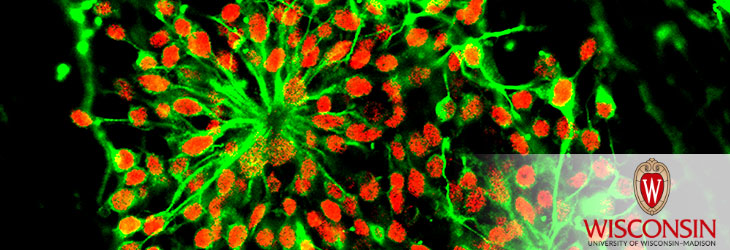Pluripotent Stem Cells

Artificial Transcription Factors and Uses Thereof
WARF: P160383US02
Inventors: Aseem Ansari, Asuka Eguchi
The Wisconsin Alumni Research Foundation (WARF) is seeking commercial partners interested in developing and employing artificial transcription factors (ATFs) to selectively alter gene expression. UW–Madison researchers have developed a library of ATFs that facilitate various cell type conversions and can thereby reveal new gene networks and mechanistic insight for improving cell therapies, drug screening and disease modeling.
Overview
Transcription factor expression can profoundly alter the transcriptional dynamics of a cell, even inducing the transition to a new cell fate. Four transcription factors – Oct4, Sox2, Klf4, and c-Myc – have been widely used to reprogram somatic cells to an induced pluripotent stem (iPS) cell state or directly to specific cell types, such as cardiomyocytes, neurons and hepatocytes.
Understanding the mechanism of these transitions is vital for ongoing medicinal and therapeutic efforts. However, current methods for finding key regulators of cell fate conversions are often labor intensive and cost prohibitive. A major challenge in identifying transcriptional regulators is distinguishing between factors/triggers that maintain the cell state verses those that drive cell fate conversion. To overcome these challenges, the inventors sought to develop a library of gene-activating artificial transcription factors (ATFs) that function independently of the cell state.
Understanding the mechanism of these transitions is vital for ongoing medicinal and therapeutic efforts. However, current methods for finding key regulators of cell fate conversions are often labor intensive and cost prohibitive. A major challenge in identifying transcriptional regulators is distinguishing between factors/triggers that maintain the cell state verses those that drive cell fate conversion. To overcome these challenges, the inventors sought to develop a library of gene-activating artificial transcription factors (ATFs) that function independently of the cell state.
The Invention
UW–Madison researchers have generated a library of ATFs that selectively alter gene expression to induce pluripotency in cells or promote the conversion of cells to specific cell fates. The inventors developed a zinc finger-based ATF library containing ~2.6 million ATFs, which can be screened in cells by looking for expression of a reporter gene, monitoring for cell surface markers or morphology, or via a functional assay.
The ATFs of the present invention facilitate cell type conversions without a priori knowledge of potential key regulators and can thereby reveal new gene networks and mechanistic pathways. The capacity of these ATFs to bind regulatory elements in the genome can enable various types of mammalian cell fate conversions, aiding in the generation of relevant cell types for cell therapies, drug screening and disease modeling.
The ATFs of the present invention facilitate cell type conversions without a priori knowledge of potential key regulators and can thereby reveal new gene networks and mechanistic pathways. The capacity of these ATFs to bind regulatory elements in the genome can enable various types of mammalian cell fate conversions, aiding in the generation of relevant cell types for cell therapies, drug screening and disease modeling.
Applications
- Gene regulation to drive various cell fate decisions
- Mechanistic study of cell fate pathways
- Discovery of new cell fate pathways for medicinal and therapeutic applications
Key Benefits
- Enables cell type conversions without a priori knowledge of potential key regulators
- Reveals unanticipated gene network dynamics that drive cell fate choices
Additional Information
For More Information About the Inventors
Related Technologies
For current licensing status, please contact Rafael Diaz at [javascript protected email address] or 608-960-9847